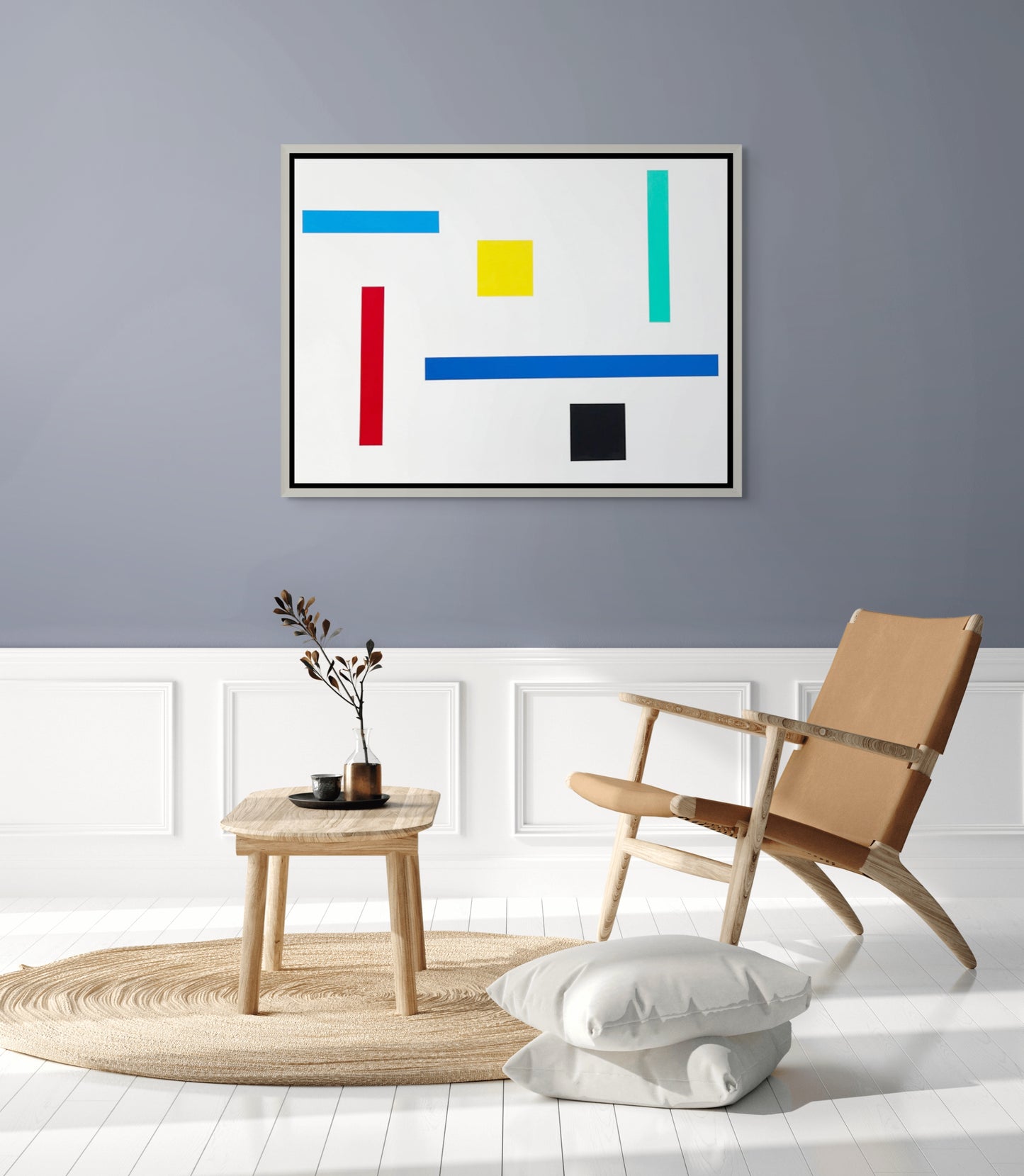Sunshine, 36" x 48"
Sunshine, 36" x 48"
See more paintings from the Floating Color Collection.

James Nowak’s Sunshine, from his Floating Color Collection, distills light and color into an abstract geometric meditation. True to the series’ thematic core, the work juxtaposes verticals, horizontals, and squares against a stark white background, creating both buoyancy and tension. While its title suggests warmth and radiance, the composition avoids literal depiction, instead reimagining the sensation of sunlight as an interaction between color, space, and balance.
The arrangement of forms in Sunshine is both sparse and intentional. A dominant vertical blue bar slightly left of center provides structural weight, acting like a stabilizing axis. Above, a red horizontal bar floats, offering counterbalance and creating a cross-like relationship with the blue vertical.
On the right, a lighter cyan vertical and a teal horizontal echo the main forms but at reduced intensity, widening the sense of spatial openness. Meanwhile, the black square in the lower left anchors the composition with gravity, countered by the bright yellow square at center-right, which functions as the painting’s radiant “sun.”
This carefully orchestrated placement achieves a balance between order and asymmetry, with each element asserting its presence while leaving breathing room in the white field.
Color is central to the meaning of Sunshine:
- Yellow is the heart of the work, radiating energy and optimism. Its position, slightly off-center, creates a glowing focal point without overpowering the composition.
- Blue—both dark and light—conveys calmness and depth, suggesting sky or atmosphere.
- Red adds intensity and warmth, evoking vitality.
- Teal and cyan expand the palette toward coolness, softening the bold contrasts.
- Black introduces gravity and solemnity, preventing the composition from drifting into pure lightness.
The palette reflects Nowak’s ability to balance emotional resonance with formal rigor, evoking the multifaceted nature of sunlight—bright, energizing, but always contrasted with shadow.
As in other works in the Floating Color Collection, the shapes here are suspended within a vast white background. The absence of perspectival depth makes the forms feel weightless, like fragments of color drifting in space. The yellow square, in particular, seems to hover like a sunbeam caught mid-air.
The interaction between the solid black square and the luminous yellow one amplifies the painting’s symbolic duality: shadow and light, heaviness and radiance, night and day. The floating geometry transforms what could be static abstraction into an image of perpetual motion and shifting balance.
Sunshine is both joyful and contemplative. The yellow square’s radiance suggests gratitude, hope, and renewal, while the stark black square tempers this brightness with a reminder of contrast. In this sense, the work embodies the paradox of sunlight itself: it gives life but also defines shadows.
The painting invites viewers to reflect on balance—not only between color and form, but between light and dark, joy and gravity, presence and absence. In doing so, it elevates simple geometry into a metaphor for human experience.
Nowak’s work resonates with the legacy of Piet Mondrian’s De Stijl, where verticals, horizontals, and primaries were deployed to evoke universal harmony. Yet unlike Mondrian’s strict grids, Nowak allows for looseness and asymmetry, producing a composition that feels alive, improvisational, and atmospheric.
At the same time, the luminous quality of Sunshine echoes the spiritual aspirations of artists like Kazimir Malevich, who sought transcendence through pure abstraction. Nowak’s divergence lies in his grounding of these forms within playful buoyancy rather than austere detachment.
James Nowak’s Sunshine exemplifies the ethos of the Floating Color Collection: abstract forms arranged to evoke sensation, energy, and meaning. With its radiant yellow square, stabilizing blue vertical, and balancing interplay of red, teal, cyan, and black, the painting captures the paradoxical essence of sunlight—simultaneously weightless and grounding, joyous and sobering. In transforming color and geometry into metaphor, Sunshine stands as a meditation on balance, radiance, and the enduring presence of light.

